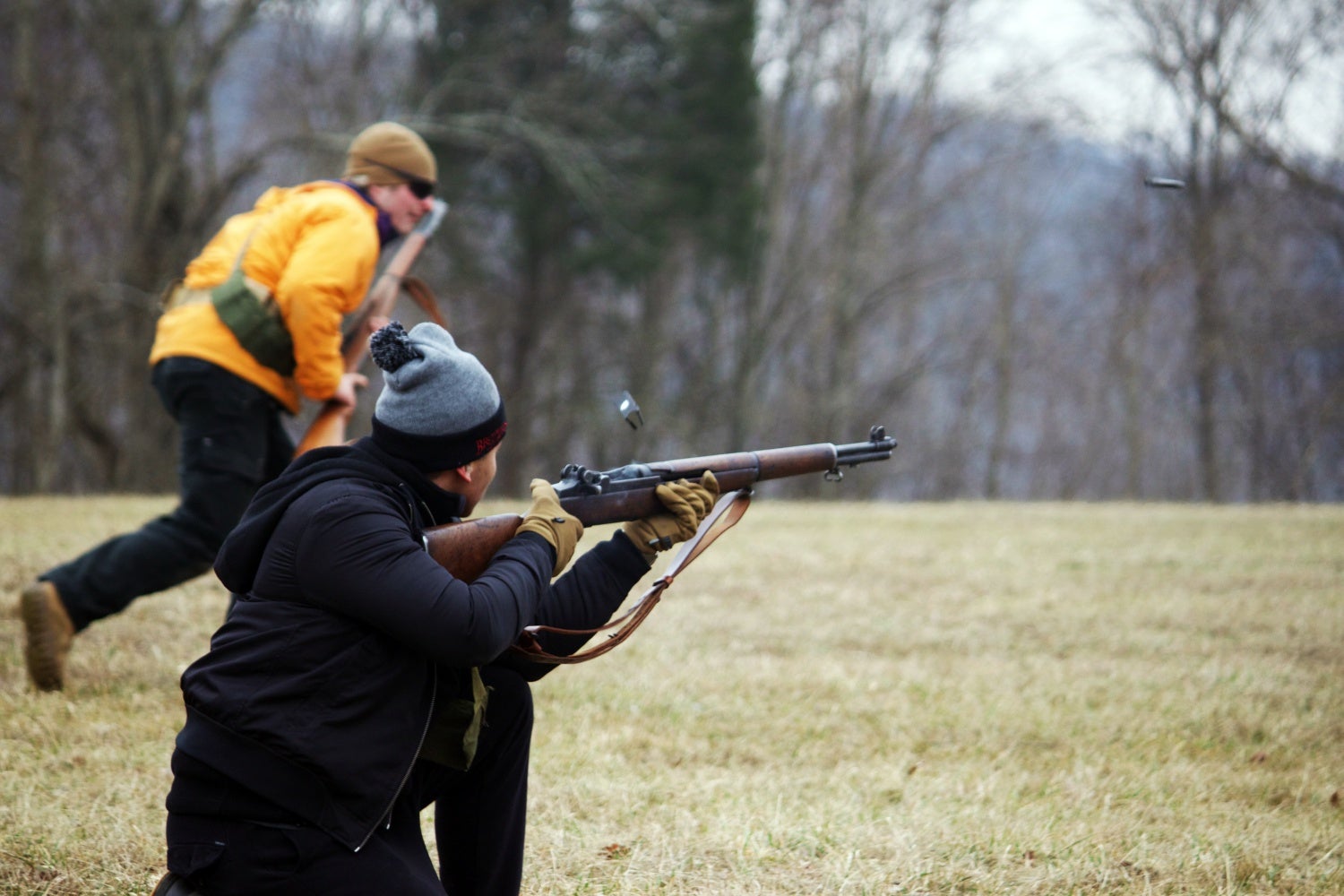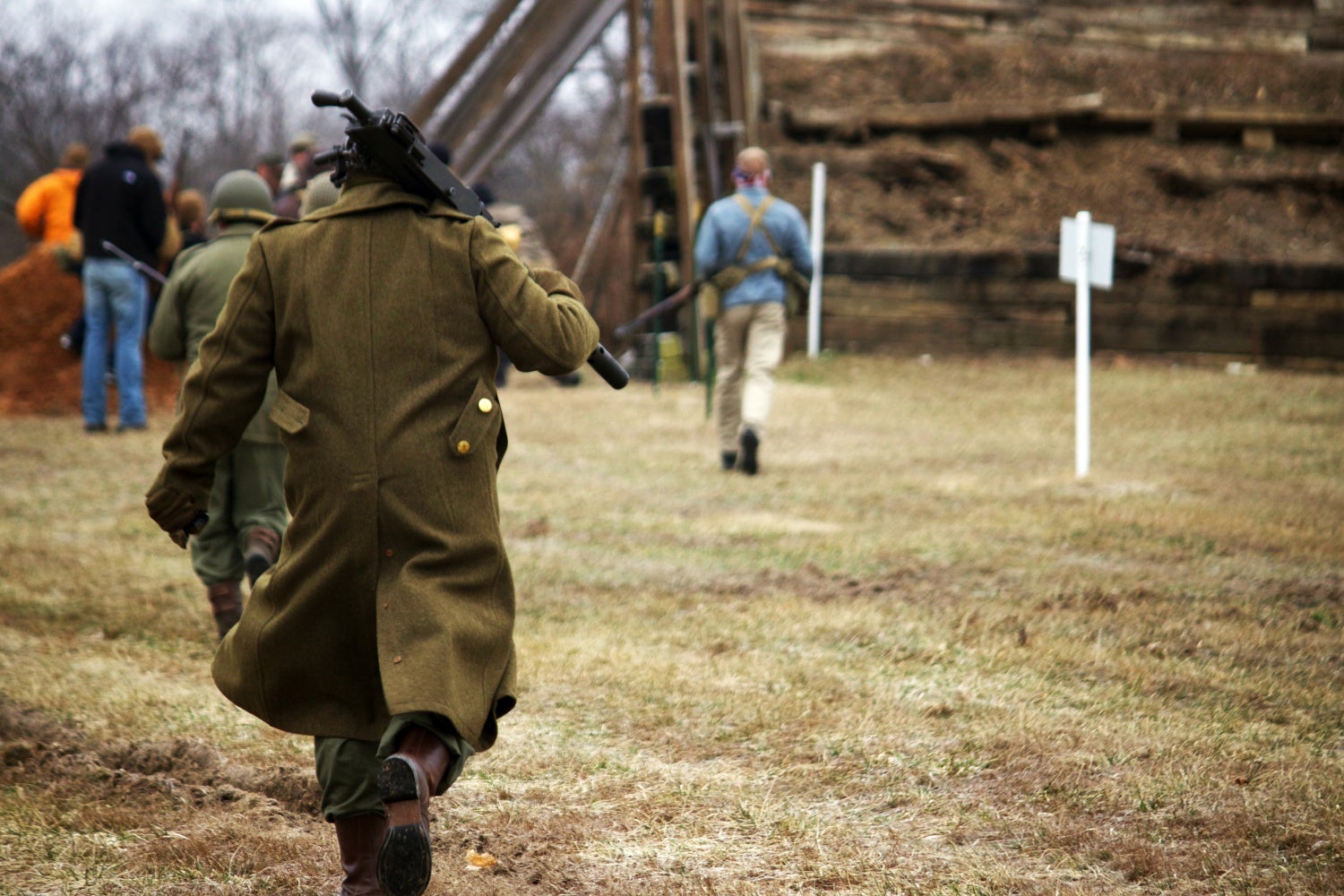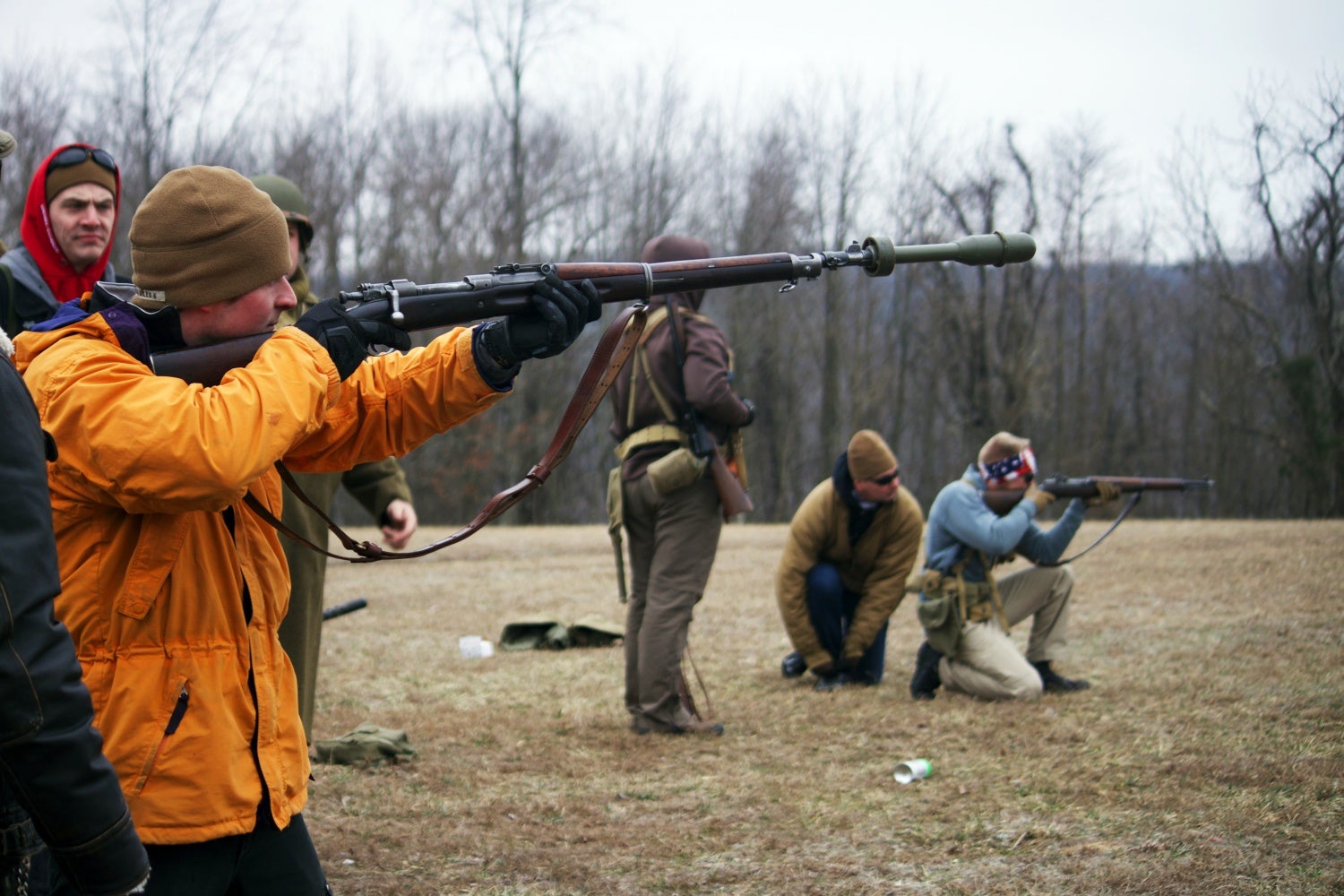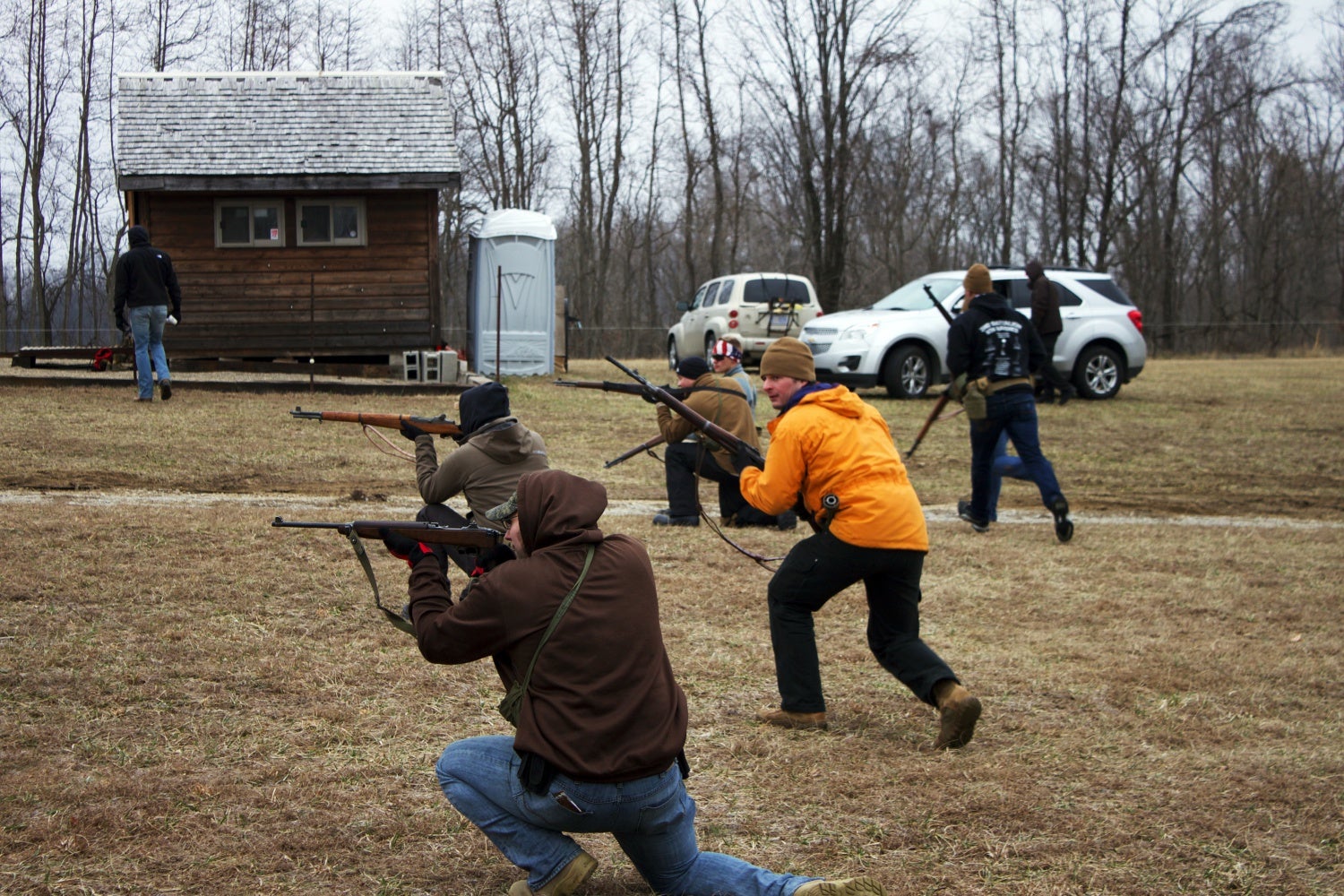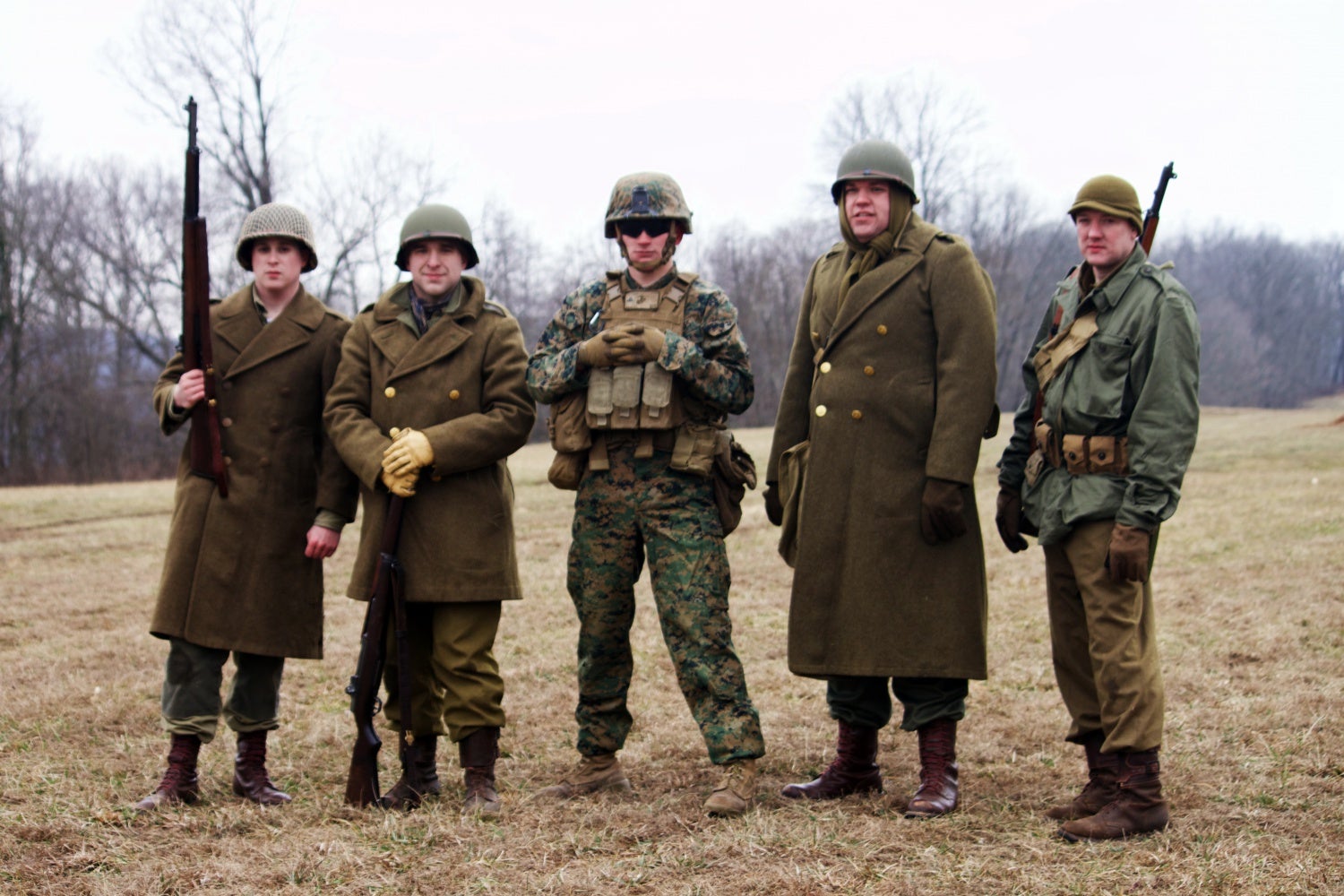The overall point of the WW II Live Fire, apart from creating an episode for our Youtube Channel, was to gain information and knowledge about these small arms that were used in World War II in ways that we couldn’t have gathered from shooting them on a square range or individually. Something that I think we really need to focus more on from a researcher or historians outlook is that these weapon systems weren’t developed and used in isolation. Sure, the M1 is a fantastic rifle for CMP matches but in all honesty that was very far from John Garand’s mind when he worked on the design. These weapons were designed to used by units of men, working very closely with each other, to accomplish an objective of overcoming an enemy force. Reenactments accomplish this well, but they don’t simulate the treatment these firearms would have gone through in combat due to the presence of live ammunition and actually trying to hit an enemy target at a distance. Bear in mind that we didn’t stage a reenactment, we staged a recreation, because we were literally trying to recreate history. If you haven’t seen the episode yet, please give it a look and then continue to read the article because it will make much more sense.
The “Ping” Myth has finally been put to rest
Bloke On the Range has done an excellent job of showing that even under prime conditions at close range the “Ping” Myth was probably just that, a myth perpetrated by people who have probably not been in mass proximity to these rifles in the way that they were used, by squads and platoons of GIs and Marines firing back at the enemy. If you listen to the audio in the episode, granted you will hear a few “Pings” but it will be just barely. And just as Bloke on the Range showed, even when those “Pings” did occur, there was substantial firepower going downrange to compensate for the lack of a rifle in the fight. At the same time you’ll hear Marines screaming, “RELOADING!” to communicate to others that the rate of fire needs to compensated. This is a tactic that is still practiced today. However I will say that when we came up online, and everyone started firing their M1s at the same time, there was a small bit of a lull in the volume of fire when everyone’s rifles emptied out at roughly the same time. This would have been a small issue to deal with as a squad leader if his entire squad began firing at an enemy location at the same time.
M1 Thumb was not as prevalent as perceived
In fact, there were absolutely zero instances of M1 Thumb happening at all throughout the day. And this was happening with the M1 shooters going through at least a cartridge belt and a bandoleer of ammunition. Also bear in mind that the overwhelming majority of the Marines present had never fired an M1 in their lives until this very day. If a group of Infantry Marines with absolutely minimal experience in operating the M1 could conduct a Live Fire attack and experience no instances of “M1 Thumb”, I’m quite confident in declaring that soldiers in WW II with months of basic training and experience in combat probably didn’t either. This is of course not to say it didn’t happen at all, but to be honest it was probably more of an issue stemming from recruits who didn’t realize any better in their basic training than an actual phenomena that happened during combat in Europe and the Pacific. Similar to the “Ping” myth, I believe both of these issues probably stemmed from training in the States with raw recruits and worried officers and SNCOs that had also never used the M1 in combat. Many of these same SNCOs and officers might have risen to positions where their word was taken as truth and that’s how it became disseminated into modern day enthusiasts and historians.
M1 Round Seating Malfunction
To be completely honest, this was the most fascinating discovery of the entire event in my eyes. Watch the above portion where I have saved the time reference to this malfunction happening. Essentially what happens is that during the course of an en bloc clip being tossed around in a cartridge belt or bandoleer, then hurriedly ripped out and jammed into an M1 in the interests of time, one or more of the rounds can become unseated so that their tips protrude further than the rest of the rounds. Now, below the chamber of the M1 there are a number of grooves and ledges where this protrusion can become stuck. Effectively jamming the clip into place wherein it can no longer be pushed into the magazine of the M1, or ejected and taken out. The best way to remedy the jam is to strip the rounds single handedly out of the clip from the top, until the offending round can also be stripped and the clip can then be ejected or pushed out.
I have only found one instance of this occurring on the internet and the shooters there blamed it on bullets being loaded differently. However, this was a problem that soldiers in WW II had to know how to fix, and fix very quickly if they were to get back in the fight. The malfunction happened to us twice, on two different rifles in the same run. Ammunition used was Greek surplus .30-06 so I don’t think it was badly loaded ammunition or else the problem would be more frequent. This particular revelation is astounding to me because through it, we literally recreated a problem that WW II soldiers had to deal with, but our knowledge of it had gotten lost in the years since WW II and the Korean War. Shooting an M1 on a square range would rarely ever see the same problem if at all. In fact even replicating the malfunction on a square range is quite tricky as well.
Machine Guns are just as heavy in 1944 as in 2017
Despite all our advancements in technology today, the machine gunners of our current military are probably humping just as much weight as their previous generation were humping in 1944. Although the M240 has decreased in weight from the 1919A4, the remainder is taken up by extra ammunition and a spare barrel. To test this, we had the machine gun team run 100 meters to get to the consolidation line, and the machine gun team was pretty much out of breath by the time they reached us due to the heavy weight of the gun, tripod, and ammunition. That was even without a full combat load of .30-06 and personal gear!
Volume of Fire
You’ll notice in the video that participants are almost screaming for their lives every time they open their mouths during the live fire. This isn’t for cinematic effect. This is because to make yourself heard over the live rounds going off, you have to burn your lungs out just to get simple commands forwarded. As for me, my voice was done for at the end of the day. There is a reason why Marine recruits are trained to “Scream for your Lives” and this is to acclimate them to communicating effectively under live fire conditions. Whether or not the actual decibel level was louder than our current 5.56x45mm weapon systems I cannot say, but I feel that the M1s produced much more volume than an M16A4 or M4. Let me also add that no one wore ear protection throughout the attack.
You can imagine just how incredibly difficult commanding a squad or platoon under these conditions is, never mind maneuvering an entire company or battalion. Simple communication becomes extremely difficult, and complex commands become impossible. In fact, in the Infantry of today, often times key leaders have to physically rush over to another key leader and scream right into their ears just to get things across. Factoring in enemy fire, artillery and vehicles such as tanks and half-tracks, and you just compound the situation even more.
Bandoleers Versus Cartridge Belts
From what we found out, loading from a bandoleer was a tremendous effort. You’re trying to pull an 8 round clip out of a piece of fabric that isn’t anchored down at all, in addition to being wedged in between two flaps of more fabric that can easily catch on the clip. Once you have accomplished that, you might also have to deal with the cardboard piece that sometimes come out with the clip (this protects the bandoleer from holes caused by the friction of the bullet). If the bandoleer has become wet, the cardboard sticks to the clip even easier. Whereas pulling a clip from a cartridge belt is drastically simple.
What I believe WW II Infantrymen would have done is similar to how we do things today. I think they would have primarily used the cartridge belt as a primary source of ammunition, and then during a lull in the fighting, take clips out of their bandoleers (secondary source of ammunition), and replaced the ones they had used in the now empty cartridge belt. However, the bandoleer does have some legitimate advantages in that it can been issued en-masse to a unit straight from the ammo spam cans it would have come with. In addition it facilitates passing off large amounts of ammunition on a battlefield that would have been time consuming with taking clips out of a cartridge belt and handing them off.
Safety? What Safety?
Working with the M1 in this setting gave us a real appreciation of the instant On-Off thumb safeties of many modern firearms. We discussed the M1’s safety catch at the start of the day and quickly realized that actuating the safety could easily lead to a negligent discharge by fumbling with a lever so close to the trigger. Thus we ran the entire attack with safeties off, and very stern trigger control. I believe WW II Infantrymen would have done the same, probably only pausing to engage the safety once fighting was over or in an extended lull.
Carbines ran out of ammunition before Garands
Despite our Carbine armed guys being issued 5 magazines of .30 Carbine (75 total), which would have put them on similar grounds with an M1’s combat load of 88 rounds, the M1A1s still ran out of ammunition faster than the Garands did. This was documented by S.L.A Marshall in his study of Infantry small arms at the end of WW II and Korea. Most likely this is due to the Carbine being a softer shooting round and the soldier using it not actually realizing how much ammunition he was burning through. Indeed, in the video you see the M1A1 armed rifleman transitioning to his 1911 because he was out of ammunition.
Rifle Grenade Employment
The largest bit we learned about rifle grenades is that we used the wrong cartridges to propel them. Rifle grenades were propelled with a special load during WW II, using a blank cartridge filled to the max with powder. Normal blank rounds would not propel the dummy rifle grenade we used to the ranges that it would have truly been effective at. In fact the standard blanks only pushed it around 50 meters!
Regardless of the effectiveness, prepping the rifle grenade took time that was much needed to return fire. We started with the launcher mounted, but soldiers in WW II would probably have had to take that time to first mount the launcher, clear the rifle (or switch to magazine cut-off on the ’03), extract a blank round, aim in and only then fire the device. And if it doesn’t have good effectives on target, repeat the process to try again. All this time, the squad has to increase the rate of fire to cover the grenadier, in addition having a rifleman out of the fight.
Command and Control at the Fire Team/Squad Level
A WW II Paratrooper Table of Organization (T/O) squad called for a maneuver element of seven men with the assistant squad leader, two scouts, and a gun team. Command would have been much larger than what we know of today at least in the Marine Corps Infantry T/O with a squad utilizing three fire teams of four Marines a piece being supported by a light machine gun. Having the flexibility of three teams drastically cuts down on the amount of control a leader has to take charge of. It is much easier to tell one team leader to push his team to the right, than to try and get seven individuals to do that same action. In our scenario the scouts and squad leader stayed with the gun team as security because the gun team on by itself cannot hold a position effectively because all of its members should be either firing, feeding ammunition, directing the fires, or bringing up ammunition.
It should also be mentioned that these three elements, the scouts, gun team, and maneuver element form the basis of small unit tactics organization. That is Assault, Support, and Security. Doctrinally speaking, security is set in place for the support element to begin suppressing an objective while the assault team moves into position to actually overtake that objective. This is exactly how the Marine Corps squad functions today in a textbook employment, and this is how WW II squads would have been trained to do as well. In addition with the gun team being placed in the middle of the squad, it allows a pivot point for the squad to maneuver with, added ease of command because leaders can easily direct it, and it is protected to the front by the scouts and squad leader, and to the rear by the maneuver element.
Suggestions for further Recreations
I really hope we can bring more of these recreations to the blog, and in addition I would absolutely love to see other enthusiasts, historians, and reenacters conduct their own as well. It just adds to the canon of knowledge that we can gain on researching just what these guys went through and how their weapon systems were effectively employed. In addition, this sort of historical recreation could be done with almost any era, to include the muzzle-loaders of the Civil War. Me personally am much more fascinated with what the guys at the lowest portion of the totem pole were going through, than anything above a company level of strategy. It ties in very well with my interest in small arms and honestly is why I chose to enlist in the Marine Corps rather than commission.
That being said, putting this event together was a logistical nightmare. It was all-volunteer, which was both a blessing and a curse. All the guys who came out to the event were extremely motivated and passionate about what needed to be done, from the reenacters, the Infantry Marines, photographers, and even the range safety officers. However at the same time I had to work on their schedule to make sure the event could fit their timeline. I had multiple participants outright cancel even up to the days leading to range day, to include two key photographers I was really counting on. On range day cameras failed because of the cold, guys had to familiarize themselves with the weapon systems, wind drowned out audio, even our pyrotechnic device that was supposed to signal the effects of the rifle grenade suffered a technical error. Probably the most annoying bit was that we had plastic “Ivan” targets set up on the steel so we could actually measure hit ratios after the attack. All of these were promptly shot off the steel because our mounting system was insufficient.
So my best advice would be to test every single point of the recreation, from the rest rooms on-site to photographers understanding what angles need to be filmed at. In addition, the safety aspects need to be adhered to religiously. We actually hired an active EMT to be on stand-by inside a warm and running safety vehicle with a separate driver just in case of a negligent discharge. Having an all Infantry veteran crew to conduct the maneuver and buddy rush portion was absolutely essential to conducting it safely. Infantrymen are very well versed in the nuisances of “Buddy Rushing” and understand the fundamentals of staying in your lane, the 15 degree “Cattle Horn” arc, and other such factors that come with experience. This is not to say it couldn’t have been done without Infantry veterans, but the safety aspect would have been much more difficult to keep a handle on due to the lack of experience with this particular activity.
The other key factor to this is the dry runs. We only ran two dry runs and one range walk-through and we really should have ran at least twice that number. But, we just didn’t have the time because some of the participants had timelines to make in the afternoon. It also could have benefited being shot in the summer and not in 30 degrees, but again, the summer wouldn’t have worked because schedules just didn’t mash up.
 Your Privacy Choices
Your Privacy Choices

